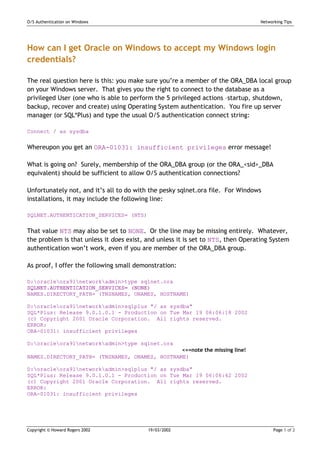Windowsosauthent
•
0 gefällt mir•243 views
oracle foreign key primary key constraints performance tuning MTS IOT 9i block size backup rman corrupted column drop rename recovery controlfile backup clone architecture database archives export dump dmp duplicate rows extents segments fragmentation hot cold blobs migration tablespace locally managed redo undo new features rollback ora-1555 shrink free space user password link TNS tnsnames.ora listener java shutdown sequence
Melden
Teilen
Melden
Teilen
Downloaden Sie, um offline zu lesen

Empfohlen
Empfohlen
Weitere ähnliche Inhalte
Andere mochten auch
Andere mochten auch (8)
Ähnlich wie Windowsosauthent
Ähnlich wie Windowsosauthent (20)
Uploading certificate with oracle wallet manager and orapki utilities

Uploading certificate with oracle wallet manager and orapki utilities
Mehr von oracle documents
Mehr von oracle documents (20)
Windowsosauthent
- 1. O/S Authentication on Windows Networking Tips How can I get Oracle on Windows to accept my Windows login credentials? The real question here is this: you make sure you’re a member of the ORA_DBA local group on your Windows server. That gives you the right to connect to the database as a privileged User (one who is able to perform the 5 privileged actions –startup, shutdown, backup, recover and create) using Operating System authentication. You fire up server manager (or SQL*Plus) and type the usual O/S authentication connect string: Connect / as sysdba Whereupon you get an ORA-01031: insufficient privileges error message! What is going on? Surely, membership of the ORA_DBA group (or the ORA_<sid>_DBA equivalent) should be sufficient to allow O/S authentication connections? Unfortunately not, and it’s all to do with the pesky sqlnet.ora file. For Windows installations, it may include the following line: SQLNET.AUTHENTICATION_SERVICES= (NTS) That value NTS may also be set to NONE. Or the line may be missing entirely. Whatever, the problem is that unless it does exist, and unless it is set to NTS, then Operating System authentication won’t work, even if you are member of the ORA_DBA group. As proof, I offer the following small demonstration: D:oracleora91networkadmin>type sqlnet.ora SQLNET.AUTHENTICATION_SERVICES= (NONE) NAMES.DIRECTORY_PATH= (TNSNAMES, ONAMES, HOSTNAME) D:oracleora91networkadmin>sqlplus "/ as sysdba" SQL*Plus: Release 9.0.1.0.1 - Production on Tue Mar 19 06:06:18 2002 (c) Copyright 2001 Oracle Corporation. All rights reserved. ERROR: ORA-01031: insufficient privileges D:oracleora91networkadmin>type sqlnet.ora <==note the missing line! NAMES.DIRECTORY_PATH= (TNSNAMES, ONAMES, HOSTNAME) D:oracleora91networkadmin>sqlplus "/ as sysdba" SQL*Plus: Release 9.0.1.0.1 - Production on Tue Mar 19 06:06:42 2002 (c) Copyright 2001 Oracle Corporation. All rights reserved. ERROR: ORA-01031: insufficient privileges Copyright © Howard Rogers 2002 19/03/2002 Page 1 of 2
- 2. O/S Authentication on Windows Networking Tips D:oracleora91networkadmin>type sqlnet.ora SQLNET.AUTHENTICATION_SERVICES= (NTS) NAMES.DIRECTORY_PATH= (TNSNAMES, ONAMES, HOSTNAME) D:oracleora91networkadmin>sqlplus "/ as sysdba" SQL*Plus: Release 9.0.1.0.1 - Production on Tue Mar 19 06:07:03 2002 (c) Copyright 2001 Oracle Corporation. All rights reserved. Connected to: Oracle9i Enterprise Edition Release 9.0.1.1.1 - Production With the Partitioning option JServer Release 9.0.1.1.1 – Production Here the three cases are demonstrated one after the other. In the first, the sqlnet.ora parameter is set to NONE. The request to connect ‘AS SYSDBA’ using O/S authentication fails. In the second, the relevant parameter is missing entirely; again the connection attempt fails. Only in the third, when the parameter is set to NTS does the connection succeed. This isn’t an issue on Unix. There, membership of the dba group in /etc/groups is sufficient in and of itself to switch on O/S authentication. It’s purely a Windows problem. Copyright © Howard Rogers 2002 19/03/2002 Page 2 of 2